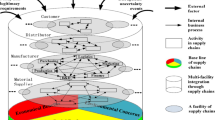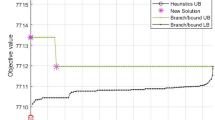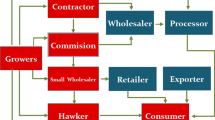Abstract
This work presents a multi-echelon, multi-period supply chain master planning in the process industry; with a concept of sustainability, carried out on a real-life case study located in Port Harcourt in the South–South region of Nigeria. A supply chain master panning model (SCMPM) takes into account the most effective and efficient method to fulfil customer order and demand over a mid-term planning horizon; it also takes of bottlenecks by assigning demands to production. A mixed integer, multi-objective optimization deterministic model was formulated which aimed at minimizing the overall system costs, emissions, social factors and customers order fulfilment in the supply chain. The Cplex solver of GAMS, with branch and cut algorithm, was used on an Intel processor with 2.30 GHz speed to run the model. The results obtained from the model with real industry data from the case study gave the objective function values as 324, 854, 340 Naira for economic factor, 26.455 tonnes of CO2 emission (170.50 g CO2), for environmental factor, while those of the social factor and allowable backorder gave 10.433 and 105 units of product, respectively. The results showed the feasibility of the formulated models and the importance to have an effective master planning supply chain decision model in place. A significant correlation between four conflicting objectives was achieved by using the weighted-sum approach and the analytic hierarchy process (AHP) thereby converting them to a single linear optimization model.




Similar content being viewed by others
Data Availability Statements
The datasets generated during and/or analysed during the current study are available from the corresponding author on reasonable request.
References
Albrecht M (2010) Supply chain planning and coordination. In Supply Chain Coordination Mechanisms (pp. 5–34).https://doi.org/10.1007/978-3-642-02833-5
Alemany MME (2010) Mathematical programming model for centralised master planning in ceramic tile supply chains. Int J Prod Res 48:5053–5074
Aliev RA, Fazlollahi B, Guirimov BG, Aliev RR (2007) Fuzzy-genetic approach to aggregate production-distribution planning in supply chain management. Inf Sci 177(20):4241–4255
Amorim P, Gunther H-O, Almada-Lobo B (2012) Multi-objective integrated production and distribution planning of perishable products. Int J Prod Econ 138(1):89–101
Arani HV, Torabi SA (2017) Integrated material-financial supply chain master planning.‘PT US CR’, Information Sciences. Elsevier Inc. https://doi.org/10.1016/j.ins.2017.09.045
Ariafar S, Ahmed S, Choudhury IA, Bakar MA (2014) Application of fuzzy optimization to production-distribution planning in supply chain management. Hindawi Publishing Corporation Mathematical Problems in Engineering, Article ID 218132. https://doi.org/10.1155/2014/218132
Ariafar S, Ismail N, Tang SH, Ariffin MKAM, Firoozi Z (2012) The reconfiguration issue of stochastic facility layout design in cellular manufacturing systems. Int J Serv Oper Manag 11(3):255–266
Badri H, Bashiri M, Hejazi TH (2013) Integrated strategic and tactical planning in a supply chain network design with a heuristic solution method. Comput Oper Res 40(4):1143–1154
Bashiri M, Badri H, Talebi J (2012) A new approach to tactical and strategic planning in production – distribution networks. Appl Math Model 36(4):1703–1717
Baykasoglu A, Gocken T (2010) Multi-objective aggregate production planning with fuzzy parameters. Adv Eng Softw 41(9):1124–1131
Beamon BM (1999) Designing the green supply chain. Logistics Inf Mgmt 12:332–342
Boulanger P, Brechet T (2005) Models for policy-making in sustainable development: the state of the art and perspectives for research. Ecol Econ 55:337–350
Carter CR (2004) Purchasing and social responsibility: a replication and extension. J Supply Chain Manag 40:4–16
Carter CR, Jennings MM (2002) Social responsibility and supply chain relationships. Transp Sci 38:37–52
Chen, Z. and Andresen, S. (2014). A multi-objective optimization model of production-sourcing for sustainable supply chain with consideration of social, environmental, and economic factors. Hindawi Publishing Corporation Mathematical Problems in Engineering. Article ID 616107, https://doi.org/10.1155/2014/616107
Chern CC, Hsieh JS (2007) A heuristic algorithm for master planning that satisfies multiple objectives. Comput Oper Res 34(11):3491–3513
Chern C, Yang I (2011) A heuristic master planning algorithm for supply chains that on sider substitutions and commonalities. Expert Syst Appl 38(12):14918–14934
Cóccola ME, Zamarripa M, Méndez CA, Espuña A (2013) Toward integrated production and distribution management in multi-echelon supply chains. Comput Chem Eng 57:78–94
Cox JF, Blackstone JH (2005) APICS Dictionary, 11th Edition. Falls Church: APICS-The Educational Society for Resource Management
Couso I, Dubois D, Sánchez L (2014) Random Sets and Random Fuzzy Sets as Ill-Perceived Random Variables: An Introduction for Ph.D. Students and Practitioners. In Springer Briefs in Computational Intelligence, Springer
Díaz-Madroñero M, Mula J, Peidro D (2014) A review of discrete-time optimization models for tactical production planning. Int J Prod Res 52:5171–5205
Elkington J (2002) Cannibals with forks: the triple bottom line of 21st century business. Capstone, Oxford
EPA (2014) Greenhouse Gas Equivalencies Calculator.URL http://www.epa.gov/cleanenergy/energy-resources/calculator
Fahimnia B, Farahani RZ, Marian R, Luong L (2013) A review and critique on integrated production-distribution planning models and techniques. J Manuf Syst 32:1–19
Firoozi Z, Ariafar Sh, Tang SH, Ariffin MKAM (2013) An optimization approach for a joint location inventory model considering quantity discount policy. Arab J Sci Eng 38(4):983–991
Gansterer M (2015) Aggregate planning and forecasting in make-to-order production systems. Int J Prod Econ. https://doi.org/10.1016/j.ijpe.2015.06.001
Ghahremani Nahr J, Pasandideh SHR. & approach for multi-objective, multi-product, multi-period, closed-loop green supply chain network designs under uncertainty and discount. J Indust Prod Eng 37(1):1–22
GhasemyYaghin R, Sarlak P, Ghareaghaji AA (2020) Robust master planning of a socially responsible supply chain under fuzzy-stochastic uncertainty (A case study of clothing industry). Eng Appl Artif Intell 94:103715. https://doi.org/10.1016/j.engappai.2020.103
Grossmann I (2005) Enterprise-wide optimization: a new frontier in process systems engineering. AIChE J 51:1846–1857
Guillén G, Badell M, Puigjaner L (2007) A holistic framework for short-term supply chain management integrating production and corporate financial planning. Int J Prod Econ 106(1):288–306
Gupta S, Dutta K (2011) Modeling of financial supply chain. Eur J Oper Res 211(1):47–56
Hammami R, Frein Y, Hadj-Alouane AB (2009) A strategic-tactical model for the supply chain design in the delocalization context: Mathematical formulation and a case study. Int J Prod Econ 122(1):351–365
Handfield R, Srouf R, Walton S (2005) Integrating environmental management and supply chain strategies. Bus Strat Env 14:1–19
ICCT (2014) International council on clean transportation. http://www.theicct.org/eu-co2-standards-passenger-cars-and-lcvs
Jin-Kwang B, Ignacio EG, Sunwon P (2000) Supply Chain Optimization in Continuous Flexible Process Networks. Ind Eng Chem Res 39(5):1279–1290. https://doi.org/10.1021/ie990526w
Kannegiesser M (2008) Value Chain Management in the Chemical Industry: Global Value Chain Planning of Commodities. Physica-Verlag, Heidelberg
Kanyalkar AP, Adil GK (2007) Aggregate and detailed production planning integrating procurement and distribution plans in a multi-site environment. Int J Prod Res 45(22):5329–5353
Kwakernaak H (1978) Fuzzy Random Variables-I. Def Theorems Inf Sci 29:1–29
Kwakernaak H (1979) Fuzzy random variables II. Algorithms and Examples for the Discrete Case. Inf Sci 17:253–278
Lazaros GP (2009) Supply chain optimisation for the process industries: Advances and opportunities. Comput Chem Eng 33(12):1931–1938
Liang T-F (2008) Fuzzy multi-objective production/distribution planning decisions with multi-product and multi-time period in a supply chain. Comput Ind Eng 55(3):676–694
Liang T-F (2013) Imprecise multi-objective production/distribution planning decisions using possibilistic programming method. J Intell Fuzzy Syst 25(1):219–230
Lin T-M, Liang T-F (2002) Aggregate production planning with multiple fuzzy goals. J Chin Instit Indust Eng 19(4):39–47
Liu YK, Liu B (2003) Fuzzy random variables: A scalar expected value operator. Fuzzy Optimization and Decision Making. pp. 143–160
Mirzapour Al-E-Hashem SMJ, Malekly H, Aryanezhad MB (2011a) A multi-objective robust optimization model for multi-product multi-site aggregate production planning in a supply chain under uncertainty. Int J Prod Econ 134(1):28–42
Mirzapour Al-E-Hashem SMJ, Baboli A, Sadjadi SJ, Aryanezhad MB (2011b) A multi-objective stochastic production distribution planning problem in an uncertain environment considering risk and workers productivity. Mathematical Problems in Engineering, Article ID 406398
Mirzapour Al-e-hashem SMJ, Baboli A, Sazvar Z (2013) A stochastic aggregate production planning model in a green supply chain: considering flexible lead times, nonlinear purchase and shortage cost functions. Eur J Oper Res 230(1):26–41
Mohammadi M, Torabi S, Tavakkoli-Moghaddam R (2014) Sustainable hub location under mixed uncertainty. Transp Res Part E: Log Transp Rev 62:89–115
Montoya-Torres JR (2015) Designing Sustainable Supply Chains Based on the Triple Bottom Line Approach. Proceedings from the 4th IEEE International Conference on Advanced logistics and Transport (ICAl T) May, 20–22, France
Mota B, Gomes MI, Carvalho A, Barbosa-Povoa AP (2015) Towards supply chain sustainability: economic, environmental and social design and planning. J Clean Prod 105:14–27
Mousazadeh M, Torabi SA, Pishvaee MS (2014) Supply Chain Management under Fuzziness C. Kahraman and B. Öztayşi, eds., Berlin, Heidelberg: Springer Berlin Heidelberg
Park YB (2005) An integrated approach for production and distribution planning in supply chain management. Int J Prod Res 43(6):1205–1224
Peidro D (2010) A fuzzy linear programming based approach for tactical supply chain planning in an uncertainty environment. Eur J Oper Res 205(1):65–80
Peidro D (2012) Fuzzy multi-objective optimisation for master planning in a ceramic supply chain. Int J Prod Res. https://doi.org/10.1080/00207543.2011.588267
Pibernik R, Sucky E (2007) An approach to inter-domain master planning in supply chains. Int J Prod Econ 108(1–2):200–212
Puri ML, Ralescu DA (1986) Fuzzy random variables. J Math Anal Appl 114:409–422
Quetschlich M, Moetz A, Otto B (2021) Optimisation model for multi-item multi-echelon supply chains with nested multi-level products. Eur J Oper Res Elsevier 290(1):144–158
Rohde J, Meyr H, Wagner M (2000) Die Supply Chain Planning Matrix. PPS Management. 5
Rohde J, Wagner M (2005) Master planning, Supply Chain Management and Advanced Planning (Third Edition): Concepts, Models, Software and Case Studies. https://doi.org/10.1007/3-540-24814-5_9
Rosenthal R (2016) GAMS - A Users Guide. GAMS Development Corporation, Washington
Rudberg M, Thulin J (2009) Centralised supply chain master planning employing advanced planning systems. Prod Plan Control 20(2):158–167. https://doi.org/10.1080/09537280802705047
Saaty TL (1980) The Analytic Hierarchy Process. McGraw-Hill, New York
Safaei AS, Moattar-Husseini SM, Farahani RZ, Jolai F, Ghodsypour SH (2010) Integrated multi-site production distribution planning in supply chain by hybrid modeling. Int J Prod Res 48(14):4043–4069
Sayeh N, Joakim W (2017) Sales and operations planning in the process industry: A literature review. Int J Prod Econ 188:139–155
Segerstedt A (2017) Cover-time planning/takt planning: a technique for materials requirement and production planning. Intern J Prod Econ. https://doi.org/10.1016/j.ijpe.2017.04.006
Selim H, Araz C, Ozkarahan I (2008) Collaborative production- distribution planning in supply chain: a fuzzy goal programming approach. Transp Res Part E: Log Transp Rev 44(3):396–419
Shah N (2005) Process industry supply chains: Advances and challenges. Centre for Process Systems Engineering, Department of Chemical Engineering, Imperial College London, London SW7 2AZ, UK. Computers and Chemical Engineering. Volume 29, Issue 6, pp. 1225–1235
Sidhartha SP, Rupesh KP, Rajeev A (2018) Framework for selecting sustainable supply chain processes and industries using an integrated approach. J Clean Prod 184:969–984
Simangunsong ES, Hendry L, Stevenson M (2012) Supply chain uncertainty: a review and theoretical foundation for future research. , pp. 37–41
Tofighi S, Torabi SA, Mansouri SA (2016) Humanitarian logistics network design under mixed uncertainty. Eur J Oper Res 250(1):239–250
Toptal A, Ozlu H, Konur D (2014) Joint decisions on inventory replenishment and emission reduction investment under different emission regulations. Int J Prod Res 52:243–269
Torabi SA, Hassini E (2008) An interactive possibilistic programming approach for multiple objective supply chain master planning. Fuzzy Sets Syst 159(2):193–214
Torabi SA, Moghaddam M (2012) Multi-site integrated production-distribution planning with trans-shipment: a fuzzy goal programming approach. Int J Prod Res 50(6):1726–1748
Turkay M (2008) Environmentally conscious supply chain management. In: Papageorgiou L, Georgiadis M (eds) Process Systems Engineering: Supply Chain Optimization. WILEY-VCH, Weinheim, pp 45–86
Turkay M, Saraçoglu O, Arslan MC (2016) Sustainability in supply chain management: Aggregate planning from sustainability perspective. PLoS ONE 11(1):e0147502. https://doi.org/10.1371/journal.pone.0147502
Vafaeenezhad T, Tavakkoli-Moghaddam R (2016) Fuzzy multi-objective supply chain master planning in a wood and paper industry: A case study. IFAC-PapersOnLine. https://doi.org/10.1016/j.ifacol.2016.07.814
Wang RC, Liang TF (2005) Applying possibilistic linear programming to aggregate production planning. Int J Prod Econ 98(3):328–341
WCED (1987) (World Commission on Environment and Development), our common future. Oxford University Press
Xu J, He Y, Gen M (2009) A class of random fuzzy programming and its application to supply chain design. Comput Ind Eng 56(3):937–950
Xu J, Liu Y (2008) Multi-objective decision making model under fuzzy random environment and its application to inventory problems. Inf Sci 178(14):2899–2914
Zahiri B, Torabi SA, Tavakkoli-Moghaddam R (2017) A novel multi-stage possibilistic stochastic programming approach (with an application in relief distribution planning). Inf Sci 385–386
Author information
Authors and Affiliations
Corresponding author
Ethics declarations
Ethical Approval
All procedures performed in studies involving human participants were in accordance with the ethical standards of the institutional and/or national research committee and with the 1964 Helsinki declaration and its later amendments or comparable ethical standards.
Research Involving Human Participants and/or Animals
This paper does not contain any studies with animals performed by any of the authors.
Informed Consent
Informed consent was obtained from all individual participants included in the study.
Conflicts of Interest
The authors declare that they have no conflict of interest.
Additional information
Publisher's Note
Springer Nature remains neutral with regard to jurisdictional claims in published maps and institutional affiliations.
Supplementary Information
Below is the link to the electronic supplementary material.
Rights and permissions
About this article
Cite this article
David, D.U., Aikhuele, D.O., Ughehe, P.O. et al. Multi-echelon, Multi-period Supply Chain Master Planning in the Food Process Industry: A Sustainability Concept. Process Integr Optim Sustain 6, 497–512 (2022). https://doi.org/10.1007/s41660-022-00229-3
Received:
Revised:
Accepted:
Published:
Issue Date:
DOI: https://doi.org/10.1007/s41660-022-00229-3




